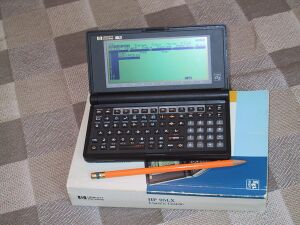Engineering:HP 95LX
 Like most pocket computers, the HP 95LX owner's manual is larger and heavier than the computer itself. | |
| Also known as | Jaguar |
|---|---|
| Manufacturer | Hewlett-Packard[1] |
| Type | Palmtop PC |
| Release date | April 1991[2] |
| Introductory price | $550 |
| Discontinued | 1 January 2003 |
| Units shipped | 400,000 (estimated production run) |
| Operating system | MS-DOS 3.22[3] |
| CPU | NEC V20 @ 5.37 MHz |
| Memory | 512 KB (F1000A) or 1 MB (F1010A)[4] |
| Removable storage | SRAM card (0.5 MB - 32 MB) |
| Display | 40 × 16 characters LCD screen (4.8 inch × 1.8 inch) |
| Graphics | 240 × 128 pixels (quarter-CGA resolution) monochrome STN, 2 scales |
| Sound | PC speaker (piezo) |
| Input | Thumb keyboard with 80 keys and a dedicated numeric keypad[5][6][7] |
| Connectivity | RS-232-compatible serial port, infrared port, PCMCIA 1.0 type II (3.3 mm or 5 mm) |
| Power | 2× AA-size removable batteries, 1× CR2032 coin cell backup, optional AC adapter |
| Dimensions | Length 8.5 cm, width 15.9 cm, height 2.6 cm (3.4 inches × 6.3 inches × 1 inch)[5] |
| Mass | 312 g (11 ounces) |
| Backward compatibility | Intel 8088 |
| Successor | HP 100LX |
The HP 95LX Palmtop PC (F1000A, F1010A), also known as project Jaguar, was Hewlett Packard's first MS-DOS-based pocket computer, or personal digital assistant, introduced in April 1991 in collaboration with Lotus Development Corporation. It can be seen as successor to a series of larger portable PCs like the HP 110 and HP 110 Plus.
Hardware
HP 95LX had an Intel 8088-clone NEC V20 CPU running at 5.37 MHz with an Intel Corporation System on a chip (SoC) device. It cannot be considered completely PC-compatible because of its quarter-CGA (MDA)-resolution LCD screen.[8]
The device also included a CR 2032 lithium coin cell for memory backup when the two AA main batteries ran out. For mass storage, HP 95LX had a single PCMCIA slot which could hold a static RAM card with its own CR 2025 back-up coin cell. An RS-232-compatible serial port was provided, as well as an infrared port for printing on compatible models of Hewlett Packard printers.[3]
Display
In character mode, the display showed 16 lines of 40 characters, and had no backlight. While most IBM-compatible PCs work with a hardware code page 437, HP 95LX's text mode font was hard-wired to code page 850 instead.[3] Lotus 1-2-3 internally used the Lotus International Character Set (LICS), but characters were translated to code page 850 for display and printing purposes.[3]
Software
The palmtop ran Microsoft's MS-DOS version 3.22[3] and had a customized version of Lotus 1-2-3 Release 2.2 built in.[9][10] Other software in read-only memory (ROM) included a calculator, an appointment calendar, a telecommunications program, and a simple text editor.
Successors
Successor models to HP 95LX include HP 100LX, HP Palmtop FX, HP 200LX, HP 1000CX, and HP OmniGo 700LX.
See also
- DIP Pocket PC
- Atari Portfolio
- Poqet PC
- Poqet PC Prime
- Poqet PC Plus
- ZEOS Pocket PC
- Yukyung Viliv N5
- Sub-notebook
- Netbook
- Palmtop PC
- Ultra-mobile PC
References
- ↑ Francis, Peter (December 1991). "HP 95LX. (palmtop computer) (Evaluation)"]. COMPUTE! (136): 128. http://www.atarimagazines.com/compute/issue136/128_HP_95LX.php.
- ↑ "Hewlett-Packard 95LX computer". oldcomputers.net. http://www.oldcomputers.net/hp95lx.html.
- ↑ 3.0 3.1 3.2 3.3 3.4 (PDF) HP 95LX User's Guide (2 ed.). Corvallis, OR, USA: Hewlett-Packard Company, Corvallis Division. June 1991. pp. E-1 – E-3, F-1 – F-7. F0001-90003. http://www.retroisle.com/others/hp95lx/OriginalDocs/95LX_UsersGuide_F1000-90001_826pages_Jun91.pdf. Retrieved 2016-11-27. "The HP 95LX character set is equivalent to code page 850, the IBM PC multilingual character set. (Note that your HP 95LX contains MS-DOS 3.22, which does not support code-page switching.) All the HP 95LX applications use this set except 1-2-3, which uses LICS, the Lotus International Character Set. Most LICS characters are included in code page 850; the few that are not will not display […] If your HP 95LX cannot display […] or if your printer cannot print a LICS character, the HP 95LX uses a fallback presentation for that character […] if you use the
©symbol and your printer cannot print it, the HP 95LX might display(c)orcas the fallback presentation (depending on the capabilities of your printer)." - ↑ "95LX". HP Computer Museum. http://www.hpmuseum.net/display_item.php?hw=202.
- ↑ 5.0 5.1 "HP 95LX: Remembering the early mobile DOS PC". ZDNet. 2015-04-07. http://www.zdnet.com/article/hp-95lx-remembering-the-early-mobile-dos-pc/.
- ↑ "HP95LX - How we test Palmtop computers". InfoWorld: 76. 1991-12-16. https://books.google.com/books?id=HD0EAAAAMBAJ&pg=PA76.
- ↑ "HP 95LX". Old Organizers Collection. http://old-organizers.com/MorePicts/MP222.htm.
- ↑ "DOS Palmtop: HP 95LX Details and specs". http://www.tankraider.com/DOSPALMTOP/hp95lx.html. (List of DOS-based palmtop computers)
- ↑ "HP 95LX". InfoWorld: 72. 1991-12-16. https://books.google.com/books?id=HD0EAAAAMBAJ&pg=PA72. Retrieved 2016-11-26.
- ↑ "Hewlett-Packard Co. HP 95LX Palmtop PC". PC Magazine: 216, 220, 222. July 1991. https://books.google.com/books?id=YfkUKcyI7KIC&pg=PT231. Retrieved 2016-11-26.
External links
- Hewlett Packard Web site on HP 95LX
- HP 95LX technical information (contains PCB photos)
- Skolob's Hewlett Packard 95LX Palmtop Page (Information and FAQ on 95LX)

